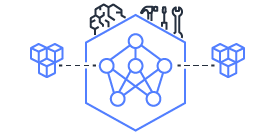This document is relevant for: Inf2, Trn1, Trn2
Fine-tuning Llama3 8B with tensor parallelism and LoRA using Neuron PyTorch-Lightning#
This tutorial shows how to fine-tune a Llama3-8B model with tensor-parallelism and LoRA adaptors. The tutorial uses the PyTorch-lightning trainer for setting up the finetuning loop.
Setting up the environment#
For this experiment, we will use one trn1.32xlarge compute instance in AWS EC2.
To set up the packages in the compute instance, see
Install PyTorch Neuron on Trn1.
Install the neuronx-distributed package inside the virtual environment using the following command:
Next, download the scripts for fine-tuning with LoRA
Create a directory to hold the experiments.
mkdir -p ~/examples/tp_llama3_8b_lora_finetune
cd ~/examples/tp_llama3_8b_lora_finetune
Download training scripts for the experiments.
We download training scripts for Llama modules, data modules, the config file of Llama3-8B, and the LoRA fine-tuning script from NxD. We also download the requirements files for package dependencies and scripts to convert Llama checkpoint to NxD checkpoint.
wget https://raw.githubusercontent.com/aws-neuron/neuronx-distributed/main/examples/training/llama/lightning/data_module.py
wget https://raw.githubusercontent.com/aws-neuron/neuronx-distributed/main/examples/training/llama/lightning/module_llama.py
wget https://raw.githubusercontent.com/aws-neuron/neuronx-distributed/main/examples/training/llama/lightning/tp_llama_hf_finetune_ptl.py
wget https://raw.githubusercontent.com/aws-neuron/neuronx-distributed/main/examples/training/llama/tp_zero1_llama_hf_pretrain/8B_config_llama3/config.json
wget https://raw.githubusercontent.com/aws-neuron/neuronx-distributed/main/examples/training/llama/lr.py
wget https://raw.githubusercontent.com/aws-neuron/neuronx-distributed/main/examples/training/llama/modeling_llama_nxd.py
wget https://raw.githubusercontent.com/aws-neuron/neuronx-distributed/main/examples/training/llama/requirements.txt
wget https://raw.githubusercontent.com/aws-neuron/neuronx-distributed/main/examples/training/llama/requirements_ptl.txt
wget https://raw.githubusercontent.com/aws-neuron/neuronx-distributed/main/examples/training/llama/training_utils.py
wget https://raw.githubusercontent.com/aws-neuron/neuronx-distributed/main/examples/training/llama/convert_checkpoints.py
wget https://raw.githubusercontent.com/aws-neuron/neuronx-distributed/main/test/integration/modules/lora/test_llama_lora_finetune.sh
wget https://raw.githubusercontent.com/huggingface/transformers/main/src/transformers/models/llama/convert_llama_weights_to_hf.py
Install the additional requirements and give the right permissions to the shell script.
python3 -m pip install -r requirements.txt
python3 -m pip install -r requirements_ptl.txt # Currently we're supporting Lightning version 2.1.0
chmod +x test_llama_lora_finetune.sh
# prepare the dataset
python3 -c "import nltk; nltk.download('punkt'); nltk.download('punkt_tab');"
Prepare the checkpoint and dataset#
Download the Llama3-8B checkpoint
Use of this model is governed by the Meta license. In order to download the model weights and tokenizer follow the instructions in meta-llama/Meta-Llama-3-8B .
Once granted access, you can download the model. For the purposes of this tutorial we assume you have saved the Llama-3-8B model in a directory called models/Llama-3-8B
Convert the llama checkpoint to NxD checkpoint
Use convert_llama_weights_to_hf.py to convert Llama checkpoint to HuggingFace checkpoint.
This script will shard Llama3-8B into multiple partitions.
In order to save it as one partition, we need to set flags max_shard_size="64GB" and safe_serialization=False in model.save_pretrained().
pip install blobfile tiktoken
cd ~/examples/tp_llama3_8b_lora_finetune
python convert_llama_weights_to_hf.py --input_dir models/Llama-3-8B/ --model_size 8B --llama_version 3 --output_dir models/Llama-3-8B-hf
When the HuggingFace checkpoint is ready, we can convert it to NxD checkpoint with
cd ~/examples/tp_llama3_8b_lora_finetune
python3 convert_checkpoints.py --tp_size 32 --qkv_linear 1 --kv_size_multiplier 4 --convert_from_full_state --config config.json --input_dir models/Llama-3-8B-hf/pytorch_model.bin --output_dir models/llama3_8b_tp32/pretrained_weight/
We then set up PRETRAINED_PATH=”models/llama3_8b_tp32” in tp_llama3_8b_lora_finetune_ptl.sh.
Set up HuggingFace Token for Llama3 Tokenizer
We need to set up HF_TOKEN in test_llama_lora_finetune.sh to configure your Huggingface Token for Llama3-8B Tokenizer.
Refer to Huggingface Access Tokens to create your Huggingface access tokens.
Set the dataset for the fine-tuning job.
In this example, we will use Dolly, which is an open source dataset of instruction-following records on categories outlined in the InstructGPT paper, including brainstorming, classification, closed QA, generation, information extraction, open QA, and summarization.
- {
“instruction”: “Alice’s parents have three daughters: Amy, Jessy, and what’s the name of the third daughter?”,
“context”: “”,
“response”: “The name of the third daughter is Alice”
}
Configure the following flags in test_llama_lora_finetune.sh to set up the dataset:
--data_dir "databricks/databricks-dolly-15k" \
--task "open_qa" \
Running fine-tuning#
Enable LoRA for fine-tuning
In test_llama_lora_finetune.sh, we also need to enable LoRA by adding the below argument
The default configuration for LoRA adapters in test_llama_lora_finetune.py is
target_modules = ["q_proj", "v_proj", "k_proj"] if flags.qkv_linear == 0 else ["qkv_proj"]
lora_config = LoraConfig(
enable_lora=flags.enable_lora,
lora_rank=16,
lora_alpha=32,
lora_dropout=0.05,
bias="none",
lora_verbose=True,
target_modules=target_modules,
)
LoRA checkpoint
There are three checkpoint saving modes for LoRA fine-tuning and we can set different modes with LoRA flags save_lora_base and merge_lora
save_lora_base=False, merge_lora=FalseSave the LoRA adapter only.save_lora_base=True, merge_lora=FalseSave both the base model and the LoRA adapter seperately.save_lora_base=True, merge_lora=TrueMerge the LoRA adapter into the base model and then save the base model.
Other than the adapter, LoRA also needs to save the LoRA configuration file for adapter loading. The configuration can be saved into the same checkpoint with the adapter, or saved as a seperately json file. An example of configurations for LoRA saving is
lora_config = LoraConfig(
...
save_lora_base=False, # save the LoRA adapter only
merge_lora=False, # do not merge LoRA adapter into the base model
save_lora_config_adapter=True, # save LoRA checkpoint and configuration file in the same checkpoint
)
After adding these flags, users can save LoRA model with
import neuronx_distributed as nxd
nxd.save_checkpoint(
checkpoint_dir_str="lora_checkpoint",
tag="lora",
model=model
)
The output checkpoints of LoRA Adapter will be saved under folder lora_checkpoint/lora/.
Note
If LoRA configuration file is saved separately, it should be placed as lora_adapter/adapter_config.json.
Run the fine-tune script
./test_llama_lora_finetune.sh
This document is relevant for: Inf2, Trn1, Trn2
